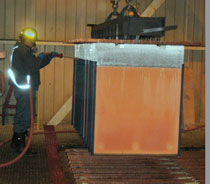
 Technical Information
Technical Information Power And Control Cables
Power And Control Cables Power Appendixes
Power Appendixes General Introduction to Cable
General Introduction to Cable History of Copper
History of Copper صفحه History of Copper
|
History of Copper
The word copper comes from the Latin word cuprum, which in turn comes from Cyprium (in English Cyprus) place from which the Romans and the Greeks obtained their copper supplies. |
||
 |
 |
 |
|
Due to its ductility and resistance to corrosion, copper and its alloys continued to be used in various utensils throughout the middle ages and the centuries that followed; but it was in 1831 when there was a twist in the history of this metal because as a result of his experiments, Michael Faraday discovered electromagnetic induction and the magnificent electrical conductivity properties of copper. At present, due to the numerous properties of copper, such as: excellent conductivity, maintains its properties in recycling and a good ductility, it is essential to our lives. Today, this noble metal contributes, among other benefits, the fact that we have efficient energy and telecommunications transmissions, the development of information technologies, an excellent urban beautification material in buildings and an efficient bactericide in piping systems, properties that will undoubtedly consolidate and promoted the use of this metal in the future. |
||
|
Advantages of Copper : * High degree of thermal and electrical conductivity. * It maintains its properties indefinitely in recycling processes. * Great resistance to corrosion. * High capacity for metallic alloy processing. * Good capacity for cold and hot deformation. * Bactericide properties (inhibits microbiological multiplication). * Basic element for vegetable and animal life (present in our internal functions). * Ductile and malleable material which permits the creation of fine cables and thin sheets. * Metallic existence in its natural state. |
 |
|





